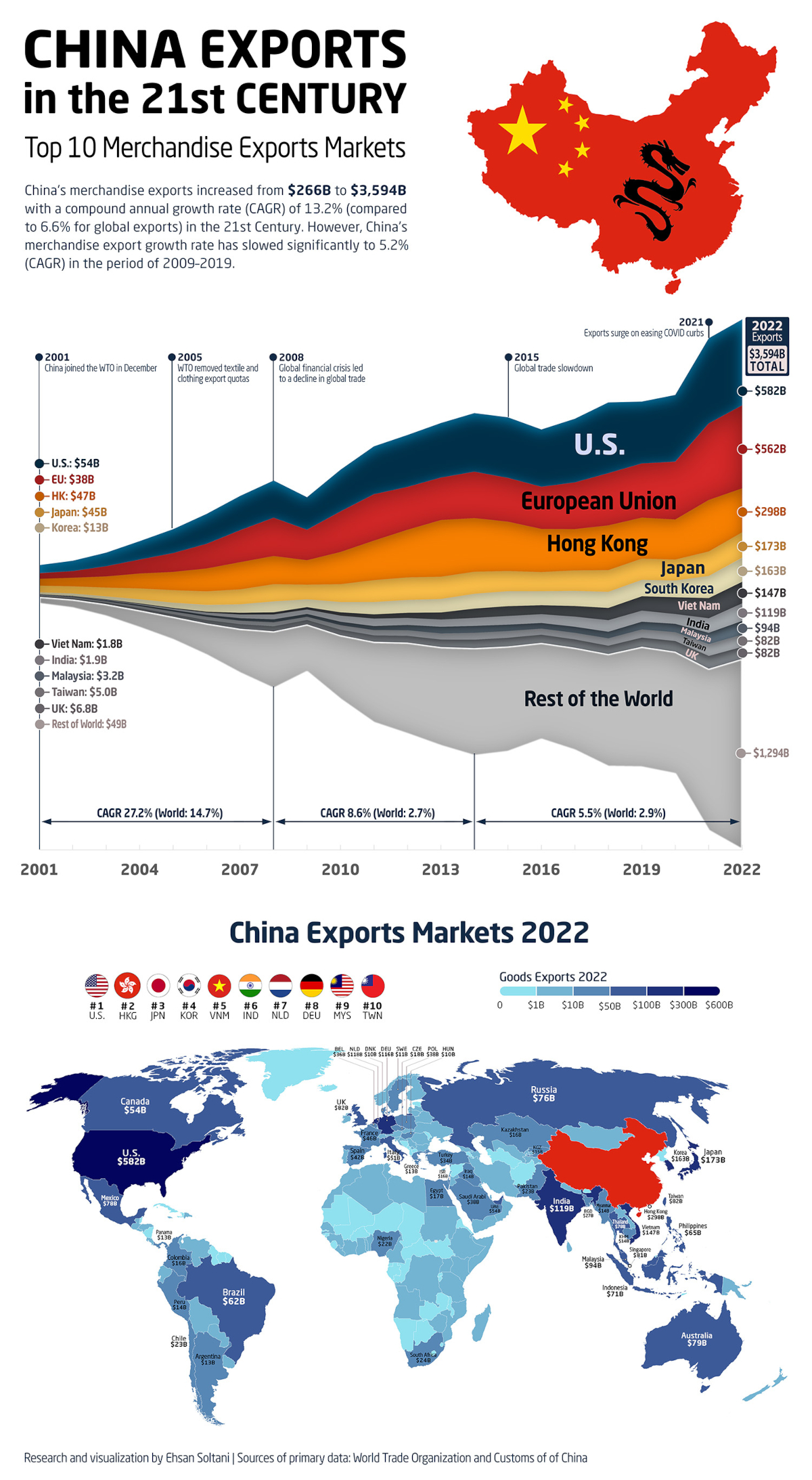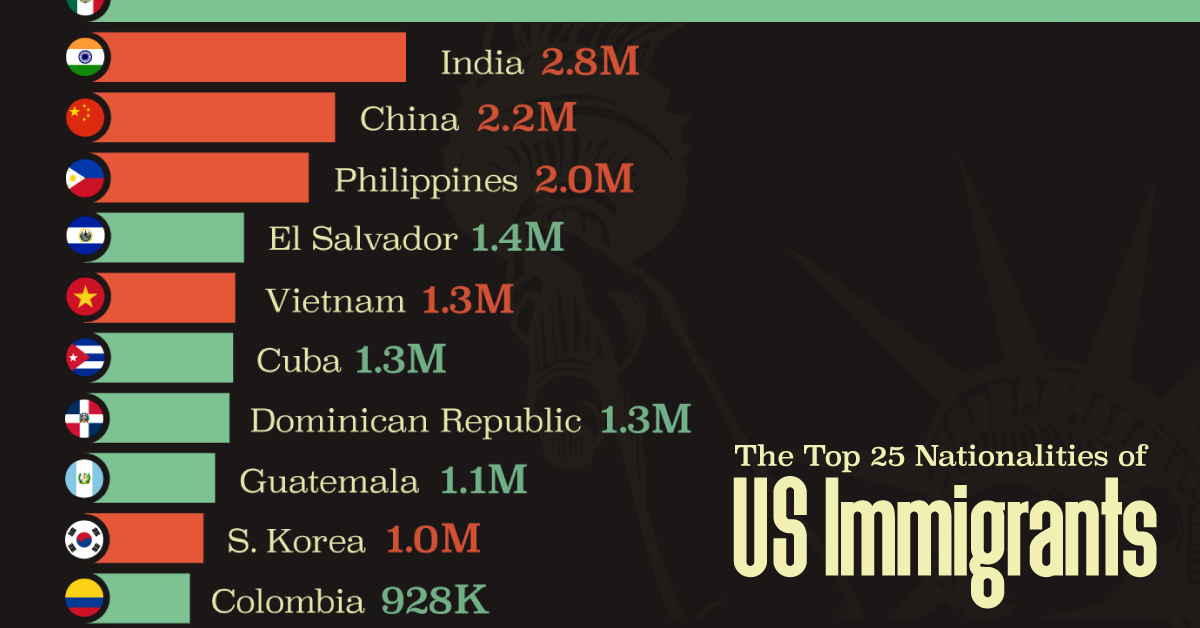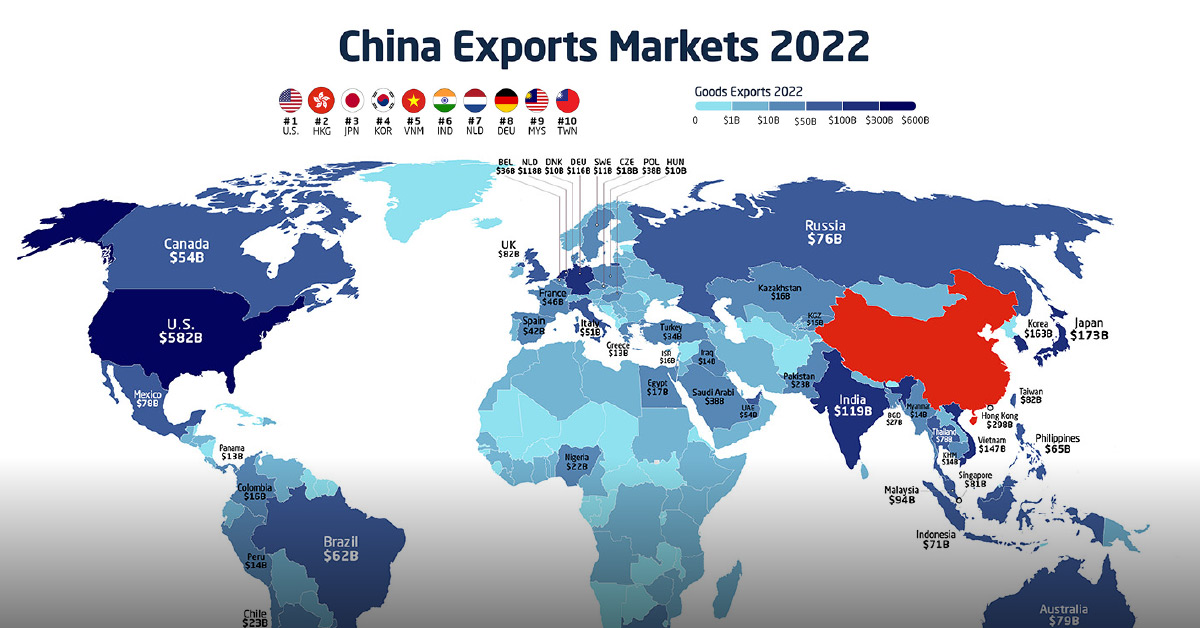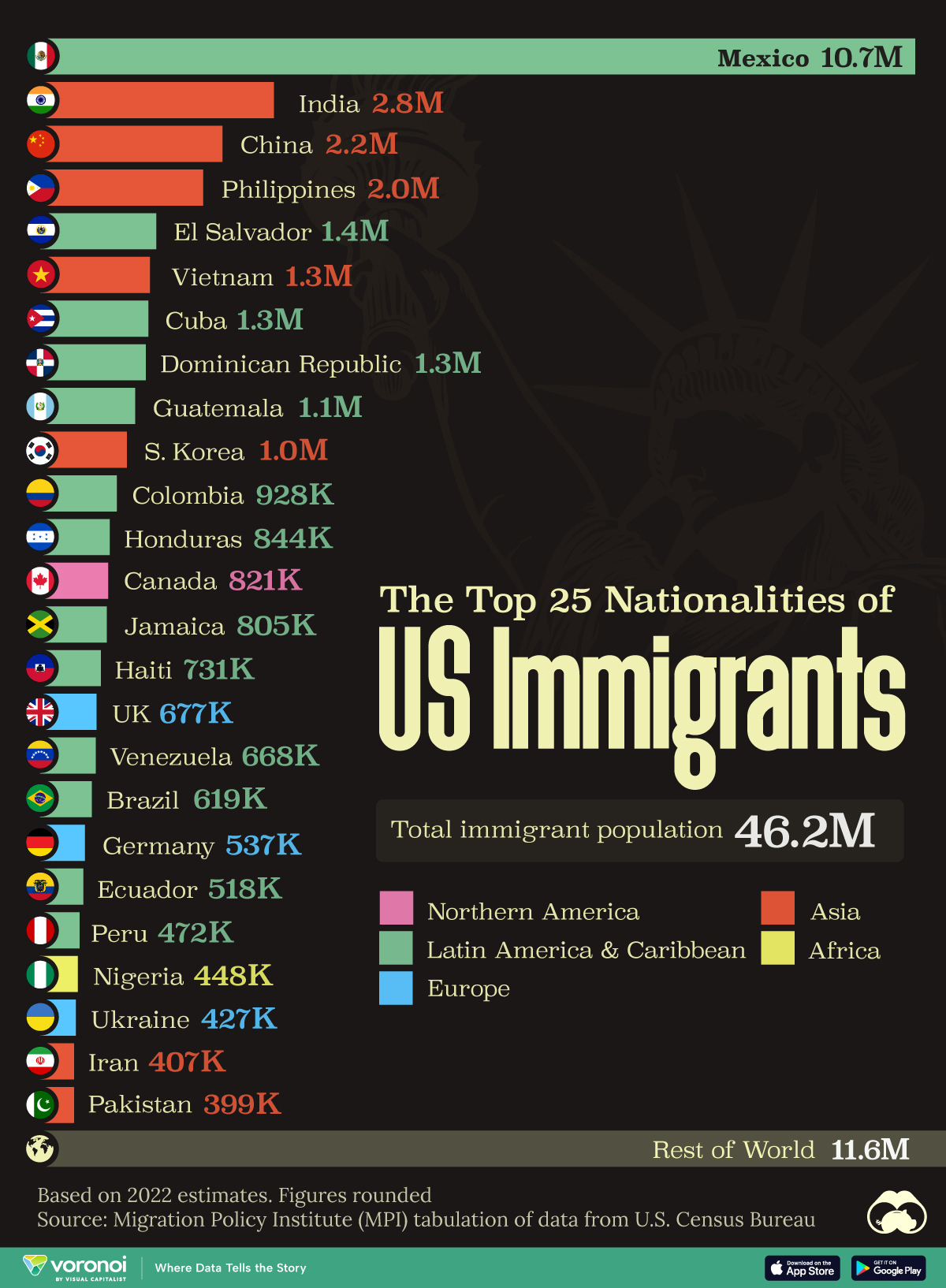Economy
Charting and Mapping China’s Exports Since 2001

Charting and Mapping China’s Exports Since 2001
Between the dawn of the Roman Empire and the first factory built in the Industrial Revolution, China was one of the most powerful economies on the planet, with a gross domestic product that made up roughly 30% of the global economy.
By the 1970s, the country’s economy had regressed to a shadow of its historic self, with a per-capita income equal to one-third of sub-Saharan Africa. But over the next four decades, China’s rapid industrial transformation made it the manufacturing powerhouse of the world, and exports rapidly ballooned.
Which markets are receiving all of these exports? This graphic from Ehsan Soltani uses data from the World Trade Organization and the customs office of China to track the biggest destinations of China’s merchandise exports—defined as goods that leave the territory of a country—since the 2000s.
China’s Top Export Markets from 2001‒2022
In 2001, when China joined the World Trade Organization, the value of its merchandise exports stood at $266 billion. Over the next seven years, the country’s exports grew uninterrupted until the 2008 financial crisis caused a sharp decline in global trade.
This cycle would repeat again with consecutive growth until 2015 (another global trade slowdown), followed by slowed growth until 2020 (the onset of the COVID-19 pandemic).
But merchandise exports skyrocketed by 30% in 2021, and by the end of 2022 had grown to an estimated $3.6 trillion per year. That means China’s exports alone are bigger than the entire economies of countries like the UK, India, and France.
Which countries were receiving most of these merchandise exports? Here are China’s top export markets from 2022 and their change since 2001:
| China's Export Market | 2001 | 2022 | Change (%) |
|---|---|---|---|
| 🇺🇸 U.S. | $54,355M | $581,783M | 970% |
| 🇪🇺 EU | $37,922M | $562,000M | 1,382% |
| 🇭🇰 Hong Kong | $46,541M | $297,538M | 539% |
| 🇯🇵 Japan | $44,941M | $172,927M | 285% |
| 🇰🇷 South Korea | $12,519M | $162,621M | 1,199% |
| 🇻🇳 Viet Nam | $1,798M | $146,960M | 8,074% |
| 🇮🇳 India | $1,896M | $118,502M | 6,150% |
| 🇲🇾 Malaysia | $3,221M | $93,711M | 2,809% |
| 🇹🇼 Taiwan | $5,001M | $81,587M | 1,531% |
| 🇬🇧 UK | $6,781M | $81,545M | 1,103% |
| 🌎 Rest of the World | $48,847M | $1,294,427M | 2,550% |
| Total | $263,822M | $3,593,601M | 1,261% |
Despite Trump-era tariffs and a growing geopolitical rift over the last few years, the U.S. has been the biggest market for China’s exports for the last two decades. In 2022, the country received nearly $582 billion in goods from China.
Close behind, the 27 member states of the European Union rank as the second biggest market for exported Chinese goods at $562 billion. The largest individual country was the Netherlands, which accounted for $118 billion or just under 21% of Chinese merchandise exports to the EU.
How do other individual countries compare? Below is the full list of China’s export markets in 2022 by countries and territories:
| Country / Territory | China Exports (2022) |
|---|---|
| U.S. | $581,783M |
| Hong Kong | $297,538M |
| Japan | $172,927M |
| South Korea | $162,621M |
| Viet Nam | $146,960M |
| India | $118,502M |
| Netherlands | $117,731M |
| Germany | $116,227M |
| Malaysia | $93,711M |
| Taiwan | $81,587M |
| UK | $81,545M |
| Singapore | $81,168M |
| Australia | $78,827M |
| Thailand | $78,480M |
| Mexico | $77,535M |
| Russia | $76,123M |
| Indonesia | $71,318M |
| Philippines | $64,679M |
| Brazil | $61,970M |
| U.A.E | $53,862M |
| Canada | $53,705M |
| Italy | $50,908M |
| France | $45,663M |
| Spain | $41,750M |
| Poland | $38,163M |
| Saudi Arabia | $37,990M |
| Belgium | $35,635M |
| Türkiye | $34,034M |
| Bangladesh | $26,808M |
| South Africa | $24,196M |
| Pakistan | $23,089M |
| Chile | $22,520M |
| Nigeria | $22,300M |
| Czech Republic | $18,227M |
| Egypt | $17,170M |
| Israel | $16,481M |
| Kazakhstan | $16,355M |
| Colombia | $15,600M |
| Kyrgyzstan | $15,421M |
| Cambodia | $14,184M |
| Iraq | $13,989M |
| Myanmar | $13,616M |
| Peru | $13,532M |
| Greece | $12,988M |
| Argentina | $12,769M |
| Panama | $12,647M |
| Sweden | $11,396M |
| Hungary | $10,473M |
| Denmark | $10,192M |
| Iran | $9,440M |
| New Zealand | $9,175M |
| Kenya | $8,249M |
| Ghana | $7,926M |
| Tanzania | $7,775M |
| Switzerland | $7,619M |
| Liberia | $7,520M |
| Uzbekistan | $7,504M |
| Romania | $7,397M |
| Slovenia | $6,861M |
| Ecuador | $6,288M |
| Algeria | $6,276M |
| Portugal | $5,978M |
| Morocco | $5,741M |
| Ireland | $5,726M |
| Jordan | $5,707M |
| Norway | $5,191M |
| Austria | $5,119M |
| Congo, DR | $5,118M |
| Kuwait | $4,970M |
| Finland | $4,553M |
| Slovakia | $4,436M |
| Guatemala | $4,366M |
| Dominican Republic | $4,319M |
| Macao | $4,277M |
| Oman | $4,205M |
| Angola | $4,097M |
| Senegal | $4,068M |
| Qatar | $3,989M |
| Sri Lanka | $3,755M |
| Cote d'Ivoire | $3,491M |
| Marshall Islands | $3,468M |
| Ukraine | $3,300M |
| Mozambique | $3,292M |
| Belarus | $3,275M |
| Djibouti | $3,262M |
| Togo | $3,177M |
| Cameroon | $3,167M |
| Venezuela | $3,009M |
| Uruguay | $2,983M |
| Mongolia | $2,887M |
| Bulgaria | $2,852M |
| Yemen | $2,798M |
| Lebanon | $2,516M |
| Libya | $2,373M |
| Costa Rica | $2,369M |
| Lao | $2,340M |
| Guinea | $2,283M |
| Croatia | $2,266M |
| Tajikistan | $2,217M |
| Ethiopia | $2,217M |
| Serbia | $2,177M |
| Sudan | $2,034M |
| Malta | $1,974M |
| Paraguay | $1,895M |
| Tunisia | $1,880M |
| Lithuania | $1,790M |
| Bahrian | $1,772M |
| Benin | $1,691M |
| El Salvador | $1,659M |
| Nepal | $1,655M |
| Honduras | $1,560M |
| Madagascar | $1,455M |
| Papua New Guinea | $1,426M |
| Georgia | $1,252M |
| Cyprus | $1,168M |
| Azerbaijan | $1,136M |
| Zimbabwe | $1,125M |
| Uganda | $1,077M |
| Bolivia | $1,067M |
| Somalia | $1,047M |
| Jamaica | $1,039M |
| Latvia | $1,025M |
| Zambia | $980M |
| Republic of Congo | $976M |
| Mauritius | $974M |
| Puerto Rico | $973M |
| Estonia | $947M |
| Mauritania | $941M |
| North Korea | $894M |
| Turkmenistan | $868M |
| Brunei | $831M |
| Nicaragua | $724M |
| Albania | $704M |
| Niger | $676M |
| Haiti | $635M |
| Gabon | $583M |
| Mali | $581M |
| Guyana | $577M |
| Sierra Leone | $573M |
| Namibia | $557M |
| Afghanistan | $553M |
| Trinidad and Tobago | $544M |
| Luxembourg | $526M |
| Burkina Faso | $504M |
| Fiji | $503M |
| Armenia | $480M |
| Gambia | $454M |
| Maldives | $451M |
| Syria | $425M |
| Cuba | $414M |
| Rwanda | $407M |
| Bahamas | $397M |
| Belize | $328M |
| Suriname | $321M |
| Iceland | $311M |
| Timor-Leste | $290M |
| Chad | $282M |
| Malawi | $281M |
| Reunion | $250M |
| North Macedonia | $235M |
| Equatorial Guinea | $231M |
| Botswana | $221M |
| Montenegro | $219M |
| Moldova | $207M |
| Solomon Islands | $196M |
| Bosnia and Hercegovina | $185M |
| New Caledonia | $169M |
| Bhutan | $166M |
| Barbados | $161M |
| Palestine | $158M |
| South Sudan | $157M |
| French Polynesia | $154M |
| Eritrea | $148M |
| Samoa | $124M |
| Burundi | $120M |
| Virgin Islands,British | $109M |
| Antigua and Barbuda | $105M |
| Vanuatu | $96M |
| Seychelles | $96M |
| Cape Verde | $93M |
| Bermuda | $83M |
| Swaziland | $82M |
| Guadeloupe | $68M |
| Comoros | $67M |
| Liechtenstein | $64M |
| Aruba | $64M |
| Curacao | $61M |
| Lesotho | $60M |
| Mayotte | $59M |
| Tonga | $57M |
| Guinea-Bissau | $57M |
| Cayman Islands | $55M |
| Palau | $54M |
| Central African Republic | $52M |
| Martinique | $48M |
| Kiribati | $43M |
| French Guiana | $39M |
| Saint Lucia | $36M |
| Dominica | $34M |
| Tuvalu | $33M |
| Micronesia,FS | $30M |
| Netherlands Antilles | $26M |
| Grenada | $23M |
| Andorra | $22M |
| St.Vincent&Grenadines | $22M |
| Gibraltar | $18M |
| Sao Tome and Principe | $15M |
| St.Kitts&Nevis | $15M |
| Nauru | $13M |
| Monaco | $12M |
| Cook Islands | $12M |
| Turks&Caicos Islands | $10M |
| San Marino | $10M |
| Saint Martin Islands | $5M |
| Canary Islands | $2M |
| Faroe Islands | $2M |
| Wallis and Futuna | $2M |
| Norfolk Island | $2M |
| Western Sahara | $1M |
| Greenland | $1M |
| Society Islands | $1M |
Will China’s Exports Continue to Grow?
Like the broader global economy, the Chinese economy is starting to re-adjust.
For one, the country is beginning to rebalance exports from its manufacturing-heavy mix to a more even allocation of both manufacturing and services. Secondly, the economy’s overall reliance on exports has decreased significantly from its highs in the mid-2000s, with an aim to increase domestic consumption and have a more self-sufficient economy overall.
That’s not to say that Chinese dominance on the world export stage is expected to waver. With far-reaching economic policies like the One Belt, One Road initiative and the RCEP trade agreement between 15 countries in Asia and Oceania, there are plenty of future growth avenues for Chinese exports.
As the country faces an unprecedented internal demographic shift in the coming decades, perhaps China’s robust export sector will be key to continued economic growth.

This article was published as a part of Visual Capitalist's Creator Program, which features data-driven visuals from some of our favorite Creators around the world.
Misc
The Top 25 Nationalities of U.S. Immigrants
Mexico is the largest source of immigrants to the U.S., with almost 11 million immigrants.

The Top 25 Nationalities of U.S. Immigrants
This was originally posted on our Voronoi app. Download the app for free on iOS or Android and discover incredible data-driven charts from a variety of trusted sources.
The United States is home to more than 46 million immigrants, constituting approximately 14% of its total population.
This graphic displays the top 25 countries of origin for U.S. immigrants, based on 2022 estimates. The data is sourced from the Migration Policy Institute (MPI), which analyzed information from the U.S. Census Bureau’s 2022 American Community Survey.
In this context, “immigrants” refer to individuals residing in the United States who were not U.S. citizens at birth.
Mexico Emerges as a Leading Source of Immigration
Mexico stands out as the largest contributor to U.S. immigration due to its geographical proximity and historical ties.
Various economic factors, including wage disparities and employment opportunities, motivate many Mexicans to seek better prospects north of the border.
| Country | Region | # of Immigrants |
|---|---|---|
| 🇲🇽 Mexico | Latin America & Caribbean | 10,678,502 |
| 🇮🇳 India | Asia | 2,839,618 |
| 🇨🇳 China | Asia | 2,217,894 |
| 🇵🇭 Philippines | Asia | 1,982,333 |
| 🇸🇻 El Salvador | Latin America & Caribbean | 1,407,622 |
| 🇻🇳 Vietnam | Asia | 1,331,192 |
| 🇨🇺 Cuba | Latin America & Caribbean | 1,312,510 |
| 🇩🇴 Dominican Republic | Latin America & Caribbean | 1,279,900 |
| 🇬🇹 Guatemala | Latin America & Caribbean | 1,148,543 |
| 🇰🇷 Korea | Asia | 1,045,100 |
| 🇨🇴 Colombia | Latin America & Caribbean | 928,053 |
| 🇭🇳 Honduras | Latin America & Caribbean | 843,774 |
| 🇨🇦 Canada | Northern America | 821,322 |
| 🇯🇲 Jamaica | Latin America & Caribbean | 804,775 |
| 🇭🇹 Haiti | Latin America & Caribbean | 730,780 |
| 🇬🇧 United Kingdom | Europe | 676,652 |
| 🇻🇪 Venezuela | Latin America & Caribbean | 667,664 |
| 🇧🇷 Brazil | Latin America & Caribbean | 618,525 |
| 🇩🇪 Germany | Europe | 537,484 |
| 🇪🇨 Ecuador | Latin America & Caribbean | 518,287 |
| 🇵🇪 Peru | Latin America & Caribbean | 471,988 |
| 🇳🇬 Nigeria | Africa | 448,405 |
| 🇺🇦 Ukraine | Europe | 427,163 |
| 🇮🇷 Iran | Middle East | 407,283 |
| 🇵🇰 Pakistan | Asia | 399,086 |
| Rest of World | 11,637,634 | |
| Total | 46,182,089 |
Mexicans are followed in this ranking by Indians, Chinese, and Filipinos, though most immigrants on this list come from countries in the Latin American and Caribbean region.
On the other hand, only three European countries are among the top sources of U.S. immigrants: the UK, Germany, and Ukraine.
Immigration continues to be a significant factor contributing to the overall growth of the U.S. population. Overall population growth has decelerated over the past decade primarily due to declining birth rates.
Between 2021 and 2022, the increase in the immigrant population accounted for 65% of the total population growth in the U.S., representing 912,000 individuals out of nearly 1.4 million.
If you enjoyed this post, be sure to check out Visualized: Why Do People Immigrate to the U.S.? This visualization shows the different reasons cited by new arrivals to America in 2021.
-

 Personal Finance1 week ago
Personal Finance1 week agoVisualizing the Tax Burden of Every U.S. State
-

 Misc6 days ago
Misc6 days agoVisualized: Aircraft Carriers by Country
-

 Culture7 days ago
Culture7 days agoHow Popular Snack Brand Logos Have Changed
-

 Mining1 week ago
Mining1 week agoVisualizing Copper Production by Country in 2023
-

 Politics1 week ago
Politics1 week agoCharted: How Americans Feel About Federal Government Agencies
-

 Healthcare1 week ago
Healthcare1 week agoWhich Countries Have the Highest Infant Mortality Rates?
-

 Demographics1 week ago
Demographics1 week agoMapped: U.S. Immigrants by Region
-

 Economy1 week ago
Economy1 week agoMapped: Southeast Asia’s GDP Per Capita, by Country













